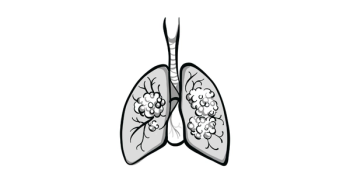
Sotorasib Shows Early Activity in Advanced Non–Small Cell Lung Cancer
In patients with non–small cell lung cancer harboring a KRAS G12C mutation, an aberration without any FDA approved treatment options, a study showed that the investigation agent, sotorasib achieved encouraging antitumor activity.
In patients with non–small cell lung cancer (NSCLC) harboring a KRAS G12C mutation, an aberration without any FDA approved treatment options, a study showed that the investigation agent, sotorasib (AMG510) achieved encouraging antitumor activity.
Findings from the study were presented during the 2020 European Society of Medical Oncology (ESMO) Virtual Congress and simultaneously published in the New England Journal of Medicine.
The investigational drug sotorasib (AMG510) demonstrated promising antitumor activity in patients with non-small cell lung cancer (NSCLC) that harbor the KRAS p.G12C mutation, an aberration for which no targeted treatment has yet been approved, according to findings presented at the 2020 ESMO Virtual Congress and published simultaneously in the New England Journal of Medicine.
In a subgroup of the multicenter, open-label, phase I CodeBreaK100 trial that included 59 heavily pretreated patients with KRAS p.G12C-positive NSCLC, researchers found that 32.2% experienced a confirmed objective response and 88.1% experienced disease control. The drug also had a favorable safety profile, David S. Hong, MD, deputy chair of investigational cancer therapeutics at The University of Texas MD Anderson Cancer Center, said. Hong, the study’s lead author, shared the data in an oral presentation at the congress.
The KRAS p.G12C mutation occurs in 13% of NSCLCs, 3% to 5% of colorectal cancers, and 1% to 3% of other cancers, Hong noted. Sotorasib, he said, is a first-in-class small molecule that selectively and irreversibly targets KRAS p.G12C.
CodeBreaK100 included 129 patients: 59 with NSCLC, 42 with colorectal cancer, and 28 with any of 11 other solid tumor types. Hong’s presentation at ESMO focused on the patients with NSCLC.
Within the NSCLC subgroup, each of 4 cohorts received a different dose of the daily oral medication: 180 mg (n=3), 360 mg (n=16), 720 mg (n=6), and 960 mg (n=34). Although tumor reduction was seen across all dose levels, 960 mg was determined to be tolerable and the most effective, and thus was studied in the trial’s expansion phase.
The study’s primary endpoint was safety, with secondary endpoints including objective response rate (ORR), duration of response (DOR), disease control rate (DCR) and progression-free survival (PFS). At a median follow-up of 11.7 months, 14 patients were still receiving treatment. Most of the 45 patients who discontinued the drug did so due to disease progression.
Study participants were a median 68 years of age (range: 49-83), 59.3% female and 89.8% current or former smokers. All had previously received platinum-based chemotherapy, and most had taken PD-1 or PD-L1 immunotherapy prior. In all but 2 cases, the patients had ECOG performance scores of 0 or 1. Although eligibility criteria disqualified patients with brain metastases, 18 developed the condition, and Hong shared a case study demonstrating that one of them experienced central nervous system response to sotorasib.
At the first of a series of scans conducted every six weeks, researchers observed tumor shrinkage of any magnitude in 42 patients (71.2%), Hong reported. In the 34 patients who took the 960 mg dose, he said, the confirmed ORR was 35.3%, or 12 patients (95% CI, 19.8-53.5), the median duration of response was 10.9 months, with 10 of 19 responders still in response as of the data cutoff of June 1, 2020. The DCR was 91.2% (95% CI, 76.3-98.1); the median duration of stable disease was 4.0 months.
There were no complete responses. The rate of stable disease was 55.9% in both the 960 mg cohort (n=19) and across the whole study population (n=33). The median time to response was 1.4 months.
The median PFS for all patients with NSCLC in the study was 6.3 months (0.0+ to 14.9 months).
There were no dose-limiting toxicities, nor were there any treatment-related deaths. Grade 3 or 4 treatment-related adverse events (AEs) occurred in 18.6% of patients. This included a single grade 4 event, increased alanine transaminase (ALT). The most common grade 3 AEs were increased ALT in 6 patients and diarrhea and increased aspartate aminotransferase (AST) in 3 patients each. The most frequent AEs of any grade were diarrhea in 15 patients and increased ALT and AST in 12 patients each.
“Sotorasib demonstrates clinical activity in NSCLC across a range of KRAS p.G12C mutant allele frequencies, PD-L1 expression levels, tumor mutational burden plasma levels, and co-mutational profiles,” Hong noted, with no particular mutation associated with a heightened response.
He added that “additional CodeBreaK trials evaluating sotorasib as a monotherapy or in combination with other anticancer agents are currently underway.”
Specifically, he said, it’s likely that sotorasib can be combined with checkpoint inhibitor immunotherapy because it “can have an immunogenic effect on the tumor microenvironment, so in combination will likely be synergistic.”
“This drug is overall relatively well tolerated and works across different dose levels,” he concluded, so “I’m confident we’ll be able to find a therapeutic window.”
Reference
Hong DS, Fakih MG, Strickler JH, et al. KRASG12C inhibition with sotorasib in advanced solid tumors. Presented at: 2020 ESMO Virtual Congress; September 19-21, 2020; Virtual. Abstract 1257O.








































